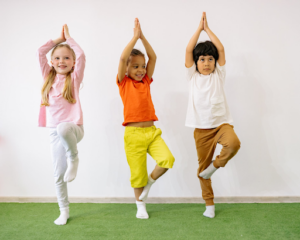
What are weighted objects, and how do they work?
In the context of pediatric therapy, a “weighted object” refers to any object or item that is worn, placed on, or carried by the body to elicit a desired sensory response. These objects work by providing deep pressure, or distributed weight over parts of the body through cuddling, hugging, squeezing, and holding, to regulate the nervous system and calm the body. Additional input is processed by the proprioceptive system, which provides information about the position and movements of our muscles and joints, to increase understanding and awareness of where our body is in space.
What are some potential benefits of using weighted objects?
Potential benefits of using weighted objects include:
1. Better attention and focus: weighted objects are often calming for children that seek opportunities for movement and deep pressure and for those that have a difficult time sitting still and attending to structured activities. As weighted objects provide the input these children are seeking, their bodies become more calm and organized, and they are better able to focus and stay on-task, especially in the classroom environment.
2. Less anxiety and improved sleep: the calming effects of weighted objects on the nervous system help to reduce sympathetic arousal, or the fight-or-flight response, and promote feelings of comfort and relaxation. For these reasons, use of weighted blankets at night has also been found to help individuals fall asleep more easily as well as improve overall quality of sleep throughout the night.
3. Smoother transitions between daily routines and activities: when children experience increased regulation and sensory organization due to the effects of weighted objects, they often feel more “in control” of their bodies and are better equipped to handle transitions and changes in their routines, leading to fewer or less intense tantrums and emotional outbursts.
What are examples of weighted objects and where can I find them?
Common examples of weighted objects include:
• Vests
• Blankets
• Lap pads
• Backpacks
• Stuffed animals
Depending on your child’s needs, weighted objects come in a variety of shapes and sizes and can be worn or held during specific activities (vest; lap pad; stuffed animal) to improve attention, carried between environments (backpack, stuffed animal) to improve smooth transitions, and placed on the body (blanket) during quiet activities, such as reading books, riding in the car, and when going to sleep, to provide comfort, reduce anxiety, and promote a calm, organized state of arousal.
Many weighted objects are available for purchase from online and in-store retailers. Weighted objects may also be created by adding weight to items already found in your home. For example, filling a long tube sock with dry rice or beans and tying off the end securely or adding these materials to one of your child’s favorite stuffed toys may work well for use as a lap pad or weighted stuffed animal. Similarly, adding books or bottles of water to your child’s backpack makes for an easy weighted adjustment during transitions to and from school. Research suggests that each object should be about 10% of the user’s body weight plus one pound to promote optimal effects, so be sure to consult with a trained therapist or doctor before trialing weighted objects with your child at home.
Do weighted objects work for every child?
While research suggests that weighted objects have several positive benefits, they may not be appropriate or suitable for every child. Objects are often most effective when implemented with other sensory strategies and should be used only as directed by your child’s occupational therapist or doctor to best target their individualized needs and ensure safe and appropriate application.
Questions or concerns?
If you have questions or concerns about whether your child may benefit from using a weighted object, please contact us at info@playworkschicago.com or 773-332-9439.
Caitlin Chociej, MS, OTR/L
Occupational Therapist
References:
Chen, H., Yang, H., Chi, H., Chen, H. (2013). Physiological Effects of Deep Touch Pressure on Anxiety Alleviation: The Weighted Blanket Approach. Journal of Medical and Biological Engineering, 33(5), 463-470. doi:10.5405/jmbe.1043
Vandenberg, N. L. (2001). The Use of a Weighted Vest to Increase On-Task Behavior in Children with Attention Difficulties. American Journal of Occupational Therapy, 55(6), 621–628. doi: 10.5014/ajot.55.6.621
Photo Credit: Naomi Shi via Pexels





